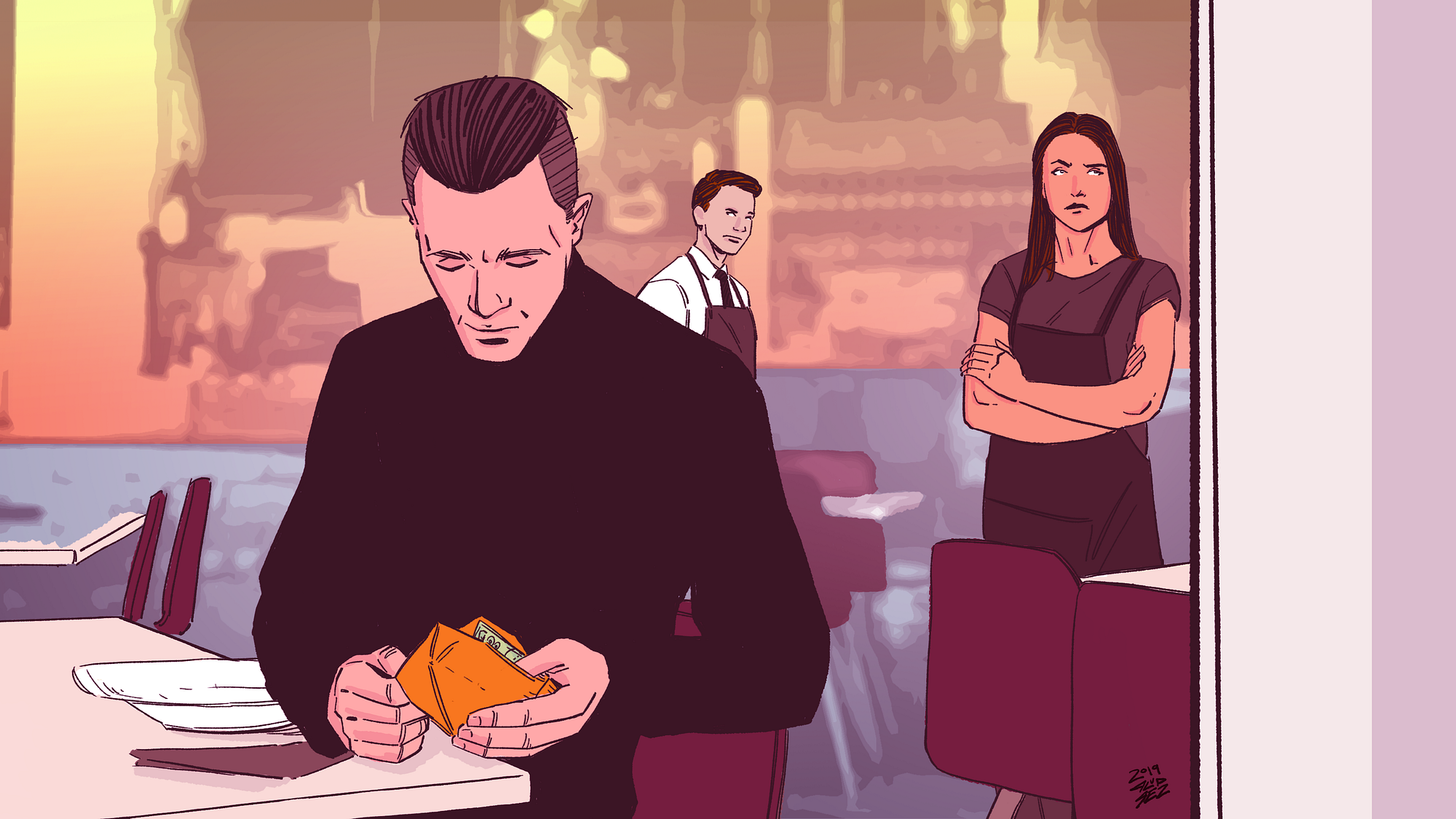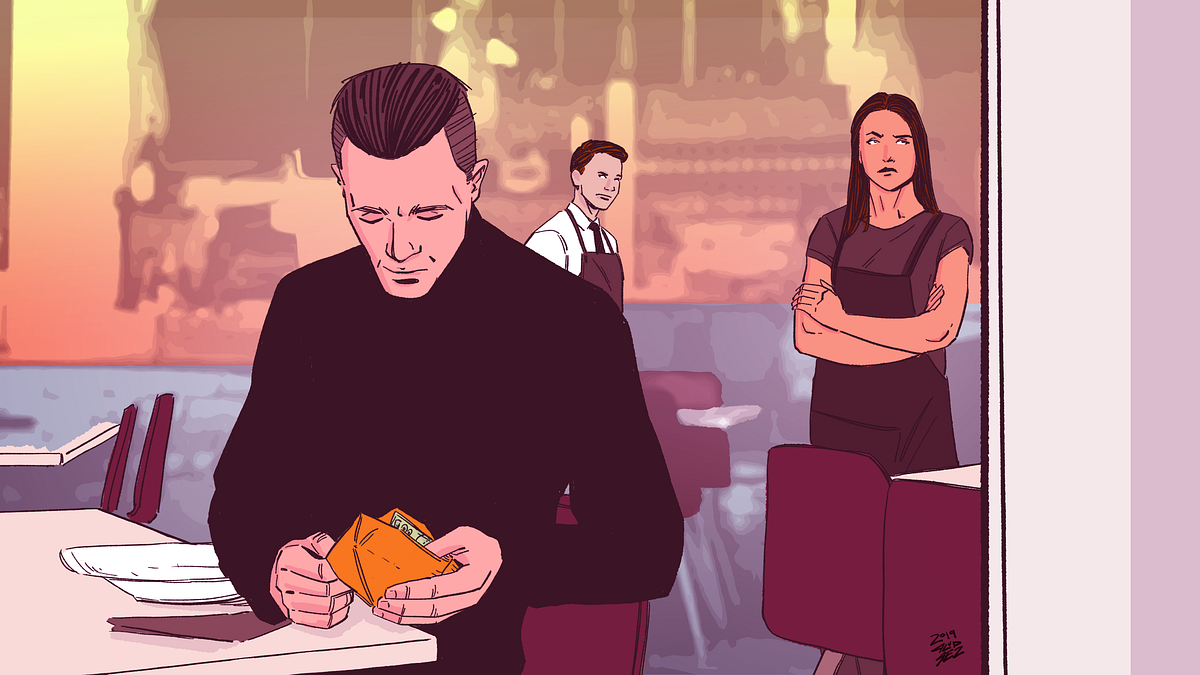
Tipping is a strange custom, but one that so far refuses to die. Ask anyone who’s ever been a server, and they’ll tell you that the quality of the service often has no bearing on the size of the tip.
So what does? All sorts of things, including race, breast size, hair color, wearing a flower in one’s hair (seriously), and, of course, the tippers themselves. As someone who’s worked in bars and restaurants for nearly a decade way back when, I noticed a pattern of behavior when the check arrived. I also recently spoke to a few longtime industry employees who verified that these archetypes still exist. They elaborated on my observations, provided new thoughts, and made me wonder whether I should be amused or dismayed that not much has changed over the decades.
Sign up for The Bold Italic newsletter to get the best of the Bay Area in your inbox every week.
To that point, we bring you the 10 types of tippers you’re most likely to find at a restaurant.
1. The Rounder Upper
They always have to make the tip equal a full-dollar amount. If the bill comes to $29.89, they’ll leave that extra 11 cents, dammit. But do they leave $5.11 or $6.11? Chances are if they’re this OCD, it’s a flip of the coin — they’re more intensely focused on the nice, neat number than on how much they’re leaving. You hope it’ll fall in your favor.
2. The Career Counselor / Verbal Tipper
They smile at you a lot and love to make conversation. Their questions will get progressively more condescending: “Where are you from?” “Do you like working here?” “What do you want to be when you grow up?” “Have you considered going back to school?” They consider their valuable time talking to an underling and giving unsolicited career advice as payment enough, so they usually cheap you out on the tip. Don’t expect more than 10%.
Along the same lines as the Career Counselor is the Verbal Tipper. They think their gushing compliments make up for the paltry 12%–15% tip. “Thanks for being amazing!” “You’re doing such a great job!” They sometimes even have the nerve to write on the check how wonderful you were. We’re pretty certain that their boss doesn’t pay them in gold stars, but for some reason, they feel it’s okay to count their thumbs-up as remuneration for you.
3. The Clock Watcher / Count Downer
They like to remind you about how long they’ve been waiting. They’re in a hot hurry, and they’re quite vociferous about how they’re reducing the amount they’re leaving on the basis of how long “you” made them wait. “Twenty minutes to get a cheeseburger? That’s coming off the tip.” These same people can be counted on to linger for half an hour or longer after the bill comes.
A close corollary to the Clock Watcher is the Count Downer, who makes it clear that they will tip 20% if you’re perfect but will tick off your failings as the visit progresses in order to leave less and less, like you’re on some perverted reverse game show. They’ll usually find enough fault with you to get it down to 10%.
4. The European Expat
Between affordable air travel and the internet, it’s generally known that tipping is ubiquitous at eateries in this country. My sources tell me that most bona fide tourists leave an acceptable amount, with one exception: European expats. They’ve lived here long enough to know better, and they’re carrying a credit card issued by an American bank, but they play like they don’t get it. Don’t expect more than 10%, if that.
5. The Boycotter
You’ve never seen them before and never will again because they are never spending another penny in this hellhole of a rat trap you call a restaurant. Something went terribly awry, and they have to punish you for slights and offenses both real and imagined that they deem unforgivable, so they’ll tip either $1 or maybe 5% just to let you know that they did not forget to tip but that you suck.
6. The To-Go Tipper
Most people won’t tip on carry-out orders because patrons don’t think they’re getting actual service since they’re not sitting at a table. However, they don’t realize that servers are often the ones who bag up the order; add any condiments, utensils, and napkins; and make sure the order is correct and packed tightly without spills — which often can require multiple trips back to the kitchen. They also get stuck at the register while the carry-out customer asks 50 questions about the menu. If they do tip, it’s often only a buck or two — or possibly the “change,” even if it’s only seven cents (see the Rounder Upper above).
7. The Attention Seekers
Tables that need the most attention are the least likely to tip, we are told. They’ll flag you down 50 times. They’ll ask the same questions over and over so they can be sure they’re ordering the “right thing” or getting the best value. They have the most dietary restrictions — or they’re simply picky. They ask for one thing each time you’re at their table: “Can we get another fork?” The fork arrives, and they need another glass of wine. The wine comes, and they need more napkins. They have no shame, and they’ll usually stiff you.
8. The Cash-and-Card Splitters
This is a group in which everyone pitches in cash, and one person reaps the greenbacks like they just won a poker game and gives you their card. This shifty diner often will keep more than their share of the agreed-upon tip (usually 20%) and shaft you, leaving maybe 15% if you’re lucky.
9. The Dog Mom/Dad
This’ll probably raise some hackles, but we’re told that some dog parents can be difficult customers because they get offended if their precious pup can’t sit on a chair or banquette next to them. Yes, we know they’re like kids. But unless you gave birth to that dog, it has to stay on the floor. This is usually enough to put people in a snit and make them pinch their pennies when tip time comes.
10. The Former Server
Your favorite customers of all time. They’ve been in the trenches themselves and know that most likely, you’re doing your best, unless you’re really hung over or just in a funk that day, in which case they can totally relate and will forgive nearly all transgressions. You can depend on a healthy 20%–25%, especially if this person was the crab that pulled themselves out of the bucket to get a degree and go on to some kind of professional setting. If they’re now living large — maybe a partner at a high-powered law firm or employee number 4 in a company that IPO’d — you can be sure to see at least 30%–35%. Bless them.







